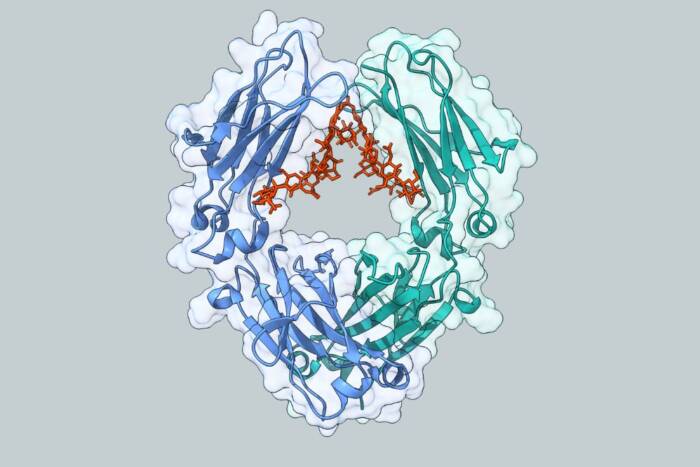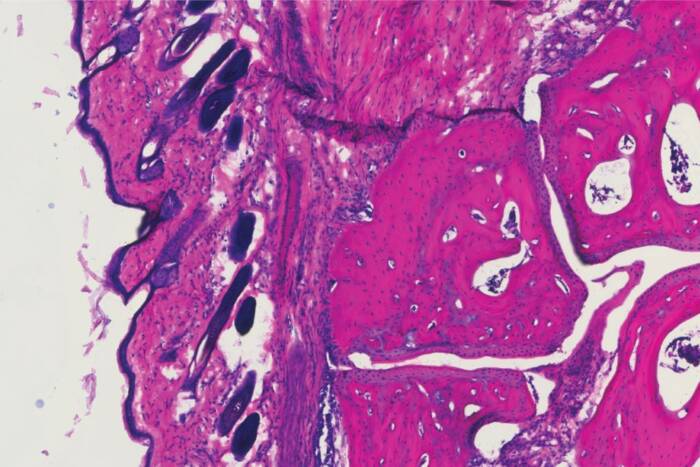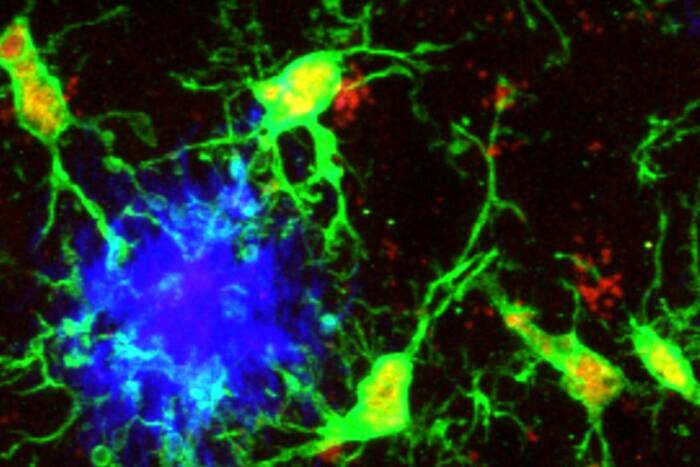Scientists finally pry stubborn cellular door ajar
Details of cystic fibrosis chloride channel exposed for first time
 Imagine a door with key and combination locks on both sides, back and front. Now imagine trying to unlock that door blind-folded. This is the challenge faced by David Gadsby, Ph.D., and his Rockefeller University colleagues, who for years have struggled to understand the highly intricate and unusual cystic fibrosis chloride channel – a cellular doorway for salt ions that is defective in people with cystic fibrosis.
Imagine a door with key and combination locks on both sides, back and front. Now imagine trying to unlock that door blind-folded. This is the challenge faced by David Gadsby, Ph.D., and his Rockefeller University colleagues, who for years have struggled to understand the highly intricate and unusual cystic fibrosis chloride channel – a cellular doorway for salt ions that is defective in people with cystic fibrosis.
Now, like a great escape artist in a bind, the researchers have employed a combination of tools, including electrophysiology and biochemistry techniques, to at last pry open the channel’s stubborn doors.
Their findings, reported in a series of three recent papers in the Journal of General Physiology, detail the type and order of molecular events required to open and close the gates of the cystic fibrosis chloride channel, or as scientists call it, the cystic fibrosis transmembrane conductance regulator (CFTR).
As a whole, the new complete model portrays a channel not so complex after all. “Once we solved the uncertainties of the old preliminary model, a new simplified version emerged,” says Gadsby, professor and head of the Laboratory of Cardiac/Membrane Physiology at Rockefeller.
Ultimately, the research may have medical applications, though ironically not likely for most cystic fibrosis patients. Because two-thirds of cystic fibrosis patients fail to produce the cystic fibrosis channel altogether, a cure for most is expected to result from research focused on replacing the lost channel; but detailed mechanistic studies like these could eventually help the other one-third.
Diseases involving a family of proteins related to CFTR, such as the sulfonylurea receptors associated with hyperinsulemic hypoglycemia (excessive insulin in the blood leading to low blood sugar) and the multidrug resistance-related proteins that interfere with cancer treatments, may one day be better treated thanks to the trio of recent studies.
“Understanding the molecular mechanisms of the CFTR protein – which can be studied using sensitive electrophysiological techniques — might help us understand how the other members of the family function,” says Rockefeller University research associate Paola Vergani, Ph.D. Vergani is first author of the second paper, published earlier this year, and second author of the most recent paper, which was published in the September issue of Journal of General Physiology.
First authors of the other two papers are Claudia Basso, Ph.D., and Athanasios G. Dousmanis, Ph.D. Basso is now at the University of Chile in Santiago, Chile, and Dousmanis is currently a clinical scholar in the Laboratory of Molecular Neuro-Oncology, headed by Robert Darnell, M.D., Ph.D. Angus C. Nairn, Ph.D., an adjunct faculty member in the Laboratory of Molecular and Cellular Neuroscience at Rockefeller, headed by Paul Greengard, Ph.D., contributed to all three papers.
No cell is an island
Like people, cells need to communicate and interact with their environment to survive. One way they go about this is through pores in their outer membranes, called ion channels, which provide charged ions, such as chloride or potassium, with their own personalized cellular doorways. But, ion channels are not like open doors; instead, they are more like gateways with high-security locks that are opened and closed to carefully control the passage of their respective ions.
In the case of CFTR, chloride ions travel in and out of the cell through the channel’s guarded pore as a means to control the flow of water in and out of cells. In cystic fibrosis patients, this delicate salt/water balance is disturbed, most prominently in the lungs, resulting in thick coats of mucus that eventually spur life-threatening infections.
Open sesame
Among the numerous ion channels in cell membranes, there are two principal types: voltage-gated and ligand-gated. Voltage-gated channels – such as the potassium ion channel whose three-dimensional structure was solved this year by Rockefeller Professor Roderick MacKinnon, M.D. – are triggered to open and shut their doors by changes in the electric potential difference across the membrane. Ligand-gated channels, in contrast, require a special “key” to unlock their doors, which usually comes in the form of a small molecule.
CFTR is a ligand-gated channel, but it’s an unusual one. Its “key” is ATP, a small molecule that plays a critical role in the storage and release of energy within cells in the body. In addition to binding the ATP, the CFTR channel must snip a phosphate group – one of three “P’s” – off the ATP molecule to function. But when, where and how often this crucial event takes place has remained obscure.
Protein puzzle
Unlike MacKinnon’s potassium ion channel, the structure of CFTR has not been solved. But researchers can piece together a rough outline of what the channel might look like based upon available structural data from related bacterial proteins as well as other biochemical findings.
Attached to the entrance of CFTR’s pore are two globular protein domains, called NBD1 and NBD2, which safeguard the channel’s doorway, controlling the opening and closing of its gates. Previous research from Gadsby’s laboratory, dating back to 1994, suggested that one ATP molecule might bind to and be cleaved at NBD1 before the channel can open. According to this same model, a second ATP molecule must bind to NBD2 to stabilize the open channel. Closing the channel was thought to require the snipping of that ATP at NBD2.
To rigorously test this preliminary model, the Rockefeller researchers employed a handful of tricks, including an electrophysiological tool called a patch-clamp. This technique begins by engineering laboratory cultures of human cells or frog eggs to carry CFTR ion channels in their membranes. Then, by placing a highly sensitive electrode over a patch of the cell membrane, the researchers can measure the tiny signals caused by the opening and closing of individual channels to learn how they work.
But there’s a twist: in place of normal CFTR channels, the scientists used mutant channels containing changes in single amino acids – the building blocks of proteins – at key binding and snipping sites. This allowed Gadsby and his colleagues to determine which binding and snipping events are required to open and close the channel. Contrary to their preliminary model, they discovered that ATP does not need to be snipped at NBD1 for the channel to open. They also learned that an ATP molecule must be bound both at NBD1 and at NBD2 before the channel can open.
But in accordance with the original model, the new patch-clamp studies indicated that the CFTR channel cannot close until the ATP bound to NBD2 is snipped.
Additional biochemical studies as well as patch-clamp experiments with living guinea pig heart cells further supported and elaborated upon this new, more unified, model. The biochemical studies even showed that the ATP stays at NBD1, without being snipped, while ATP comes and goes at NBD2 many times, each time causing the CFTR channel to open and close.
“We are now able to link the timing of ATP binding and hydrolysis in the NBDs, to the timing of specific protein movements that open and close the pore,” says Vergani.
ATP sandwich
But this is not yet the end of the channel’s story. It is still not clear exactly how the binding and the snipping of ATP cause the channel’s gates to open and shut. Gadsby and his Rockefeller colleagues propose that the answer may resemble a sandwich. Building on the structural evidence from bacterial proteins, the researchers believe that the channel opens when the two NBD domains form a sandwich, with the two bound ATPs making up the meat. According to this theory, the channel closes once a part is snipped off the ATP at NBD2, because the sandwich in essence can then no longer hold itself together.
Presently, the scientists are further investigating this theory as well as additional questions regarding CFTR’s intricate inner workings. Though they may have found the keys to the channel’s doors, the locks themselves hold still more mysteries.
This research was supported in part by the National Institutes of Health, Cystic Fibrosis Foundation and Cystic Fibrosis Association of Greater New York.


